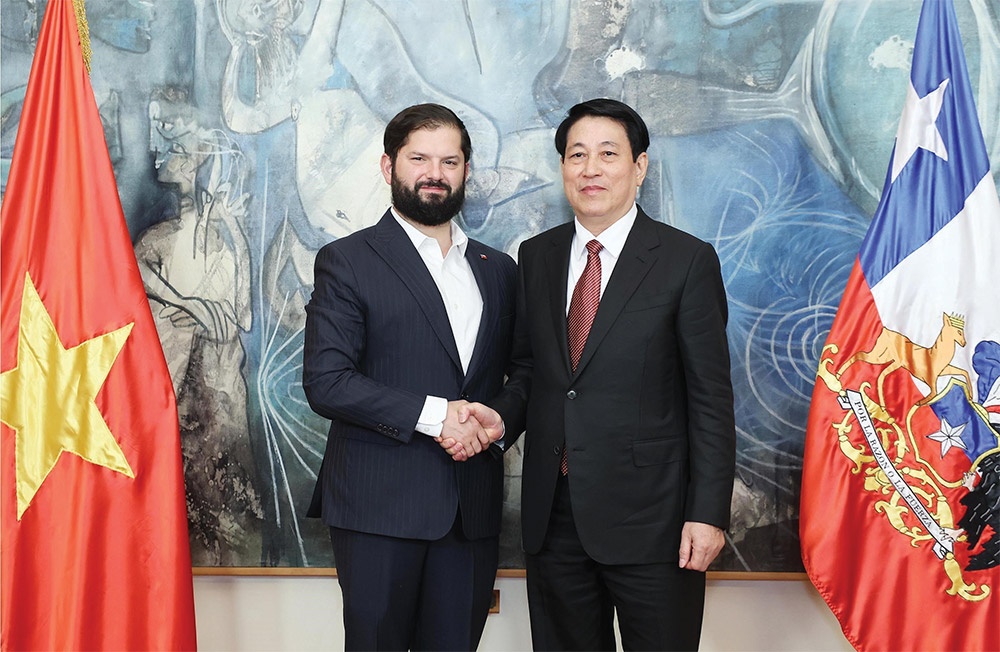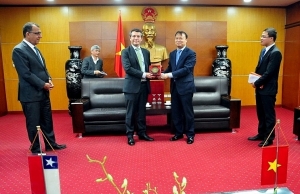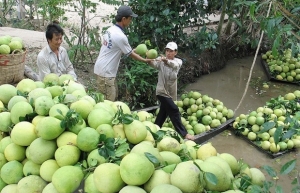Chile visit underscores trade benefits
During Vietnamese State President Luong Cuong’s official visit to Chile last week, he and his counterpart Gabriel Boric Font agreed that the two nations’ trade and investment cooperation must be further increased as a key pillar in the bilateral cooperation, for the “development and prosperity of the two countries.”
“In that spirit, the two leaders underlined the importance of the free trade agreement (FTA) between Vietnam and Chile on the occasion of the 10th anniversary of the deal’s entry into force, as well as the importance of the Comprehensive and Progressive Agreement for Trans-Pacific Partnership in which the two countries are members to the bilateral relationship,” read a joint statement between Vietnam and Chile released last week. “The two leaders agreed to continue increasing coordination in order to improve the implementation of these agreements.”
 |
| President Luong Cuong (right) and his Chilean counterpart Gabriel Boric Font held talks in Santiago, Chile, photo VNA |
Notably, with a view to further deepening the trade and investment ties, Chile has stressed its desire to join the Regional Comprehensive Economic Partnership (RCEP), and Vietnam welcomes this proposal and will continue pushing up discussions among the deal’s member states about this issue, the statement added.
The RCEP aims to reduce or eliminate customs duties imposed by each member state on originating goods by approximately 92 per cent over a period of 20 years. Each member state sets out specific duty reduction commitments in respect of other exporting member states.
One major advantage for claiming preferential treatment under the RCEP is that the cumulation rule, which allows originating goods from one member state used as material in the production of a new product in another member state to be considered as originating in the second member state, allows for increased ability to cross-share resources among the 15 member states.
For example, materials originating in China may not count towards originating materials in the
ASEAN-Japan Free Trade Agreement, but it can be considered as originating material under the RCEP. This allows for increased flexibility and greater integration of supply chain across the region.
In June, Claudia Sanhueza Riveros, Deputy Minister for International Economic Relations of the Ministry of Foreign Affairs of Chile, handed over an official letter of request to join RCEP to the ASEAN Secretariat. Chile has a high degree of economic openness and with 33 negotiated FTAs covering 65 economies, accounting for 88 per cent of the world’s GDP, according to the US International Trade Administration. It is pursuing an open and free market economy, diversifying its export markets, and attracting foreign investment via FTAs. Its accession to RCEP is expected to expand the scope of this deal to South America, a region where ASEAN nations currently have no such deals.
The Vietnam-Chile trade turnover hit $1.5 billion last year and $1.57 billion in the first nine months of this year – up 5 per cent as compared to the same period last year. Chile is now the fourth-largest trade partner in the Latin America region, and Vietnam is now the largest trade partner of Chile in Southeast Asia.
Currently, Chile has only four valid projects in Hanoi and Ho Chi Minh City, worth $300,000.
Last week, Vietnam and Chile also committed to expanding bilateral cooperation across sectors of mutual interest, including free trade, agriculture, sustainable development, renewable energy, science, education, culture, and tourism.
They also acknowledged the necessity of opening their markets to each other’s agricultural and aquatic products, and expressed their interest in continuing to streamline procedures for market access for the goods.
The Vietnamese and Chilean leaders last week agreed to assign ministries and agencies of both sides to exchange, review, and update the regulations in the existing comprehensive partnership forged in 2007, in order to consider an upgrade of this partnership to a higher level to make bigger room for the bilateral relationship and determining new strategic and breakthrough cooperation priorities in the time to come.
In related news, during Vietnamese State President Cuong’s official to Peru last week, Vietnam and this nation agreed on major directions and measures to further deepen bilateral ties across various sectors. These include increasing high-level exchanges and meetings, strengthening cooperation mechanisms and legal frameworks, expanding diplomatic and consular presence, and facilitating business connections, trade and investment promotion, and transport and logistics links. They also consented to enhance cultural and educational collaboration, and people-to-people interactions.
 | Chile and Vietnam to discuss bolstering trade co-operation In his very first visit to Vietnam on January 20, Rodrigo Yañez, Vice Minister of Trade for Chile, shared with VIR some key points of improvement in the trade relationship between Chile and Vietnam. |
 | Chile opens door for Vietnam’s pomelo Chilean authorities have granted permission for Vietnam to ship pomelo to the Latin American market, according to Minister of Agriculture of Chile Antonio Walker. |
What the stars mean:
★ Poor ★ ★ Promising ★★★ Good ★★★★ Very good ★★★★★ Exceptional
Related Contents
Latest News
More News
- Global partnerships key to Vietnam’s IFC development (December 26, 2025 | 16:18)
- Vingroup pulls out of bid to invest in North-South high-speed railway (December 26, 2025 | 11:42)
- Strengthening supply chains through trade promotions and customs reform (December 24, 2025 | 14:00)
- PM orders investment model for North–South high-speed rail (December 22, 2025 | 17:43)
- LS Eco Energy to invest in Vietnam rare earth sector (December 22, 2025 | 17:31)
- Government moves to establish International Financial Centre (December 21, 2025 | 21:00)
- Vietnam's IFC to target global investment flows (December 21, 2025 | 18:00)
- Two national hospitals expand capacity with new facilities (December 20, 2025 | 09:00)
- Ha Tinh breaks ground on major Vingroup industrial and energy projects (December 19, 2025 | 18:24)
- EVN launches major power infrastructure projects nationwide (December 19, 2025 | 18:17)

 Tag:
Tag:





















 Mobile Version
Mobile Version